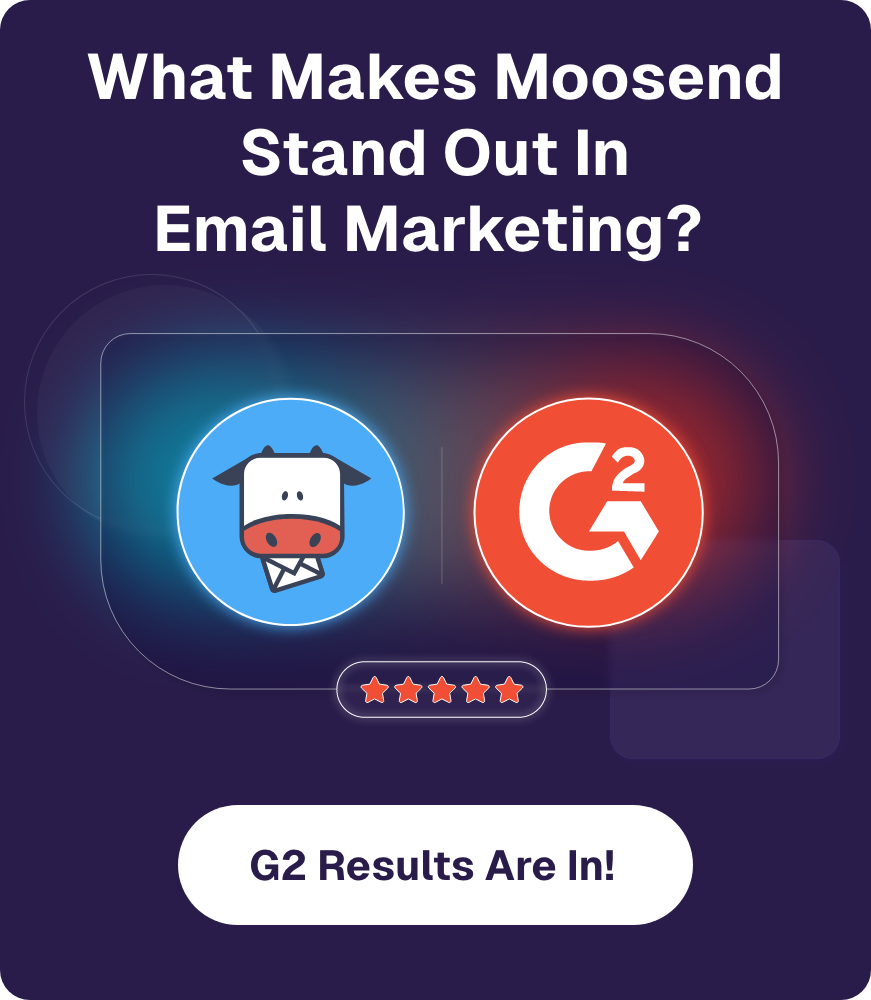
Klaviyo vs Mailchimp: 2025 Comparison [Honest Opinions]
When it comes to email marketing for eCommerce, Klaviyo and Mailchimp are two of the most popular choices. Both platforms offer powerful tools to help online stores grow their customer base, drive repeat purchases, and boost their revenue. But despite certain similarities, they take a different approach to how they support eCommerce brands.
Klaviyo positions itself as a data-driven solution built specifically for online retailers, while Mailchimp has a broader appeal, catering to a wider range of business types. For eCommerce merchants, understanding how these platforms compare in terms of automation, AI functionality, email deliverability, and customer support is key to making the right choice.
In this Klaviyo vs Mailchimp comparison, we explore the key differences between the two, highlight their strengths and limitations, and provide a clear side-by-side comparison to help you decide which platform is the best fit for your online store.
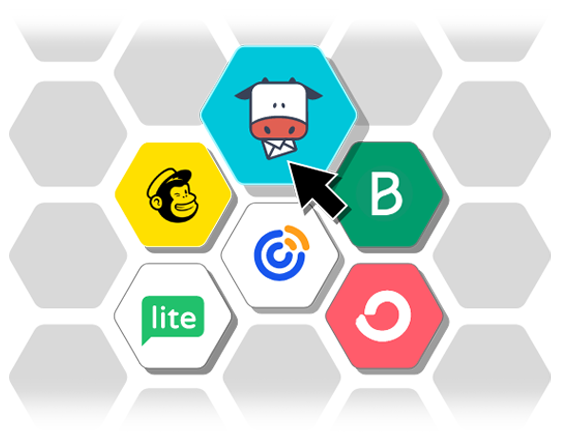
Save $$$ of your marketing budget by switching to Moosend today!
Klaviyo vs Mailchimp: Feature Comparison
Here’s a quick overview of our comparison:
- Klaviyo has deep eCommerce functionality with advanced automation, real-time segmentation, and revenue-focused analytics.
- Mailchimp provides a broader, more beginner-friendly toolset with flexible design features and general marketing capabilities.
| Klaviyo | Mailchimp | |
| Free plan | Yes (limited) | Yes (limited) |
| Pricing | $20/month (500 contacts – 5,000 emails) | $13/month (500 contacts – 5,000 emails) |
| Best for | eCommerce | eCommerce, Publishers, SMBs |
| Email tools | 119 pre-made templates, A/B testing, Advanced segmentation | 137 pre-made templates, Content studio, A/B testing |
| Marketing automation | Advanced | Advanced |
| Reporting & Analytics | Extensive | Extensive |
| Signup forms | Yes | Yes |
| Landing pages | No | Yes |
| SMS marketing | US, CA, UK, IE, DE, FR, AUS, NZ, AT, ES, CH, NL, DK, FI, NO, SE, IT, PT, BE | US only |
| Integrations | 360 | 335 |
| Customer support | 3/5 | 3.5/5 |
| AI features | AI generation for email subject lines and email content, AI generated flows and segments, Predictive analytics, A/B testing automation | AI content generation for email (beta), Subject line helper, AI-generated automations (beta) |
Now let’s see more details about each category.
Setup & Ease of Use
Klaviyo:
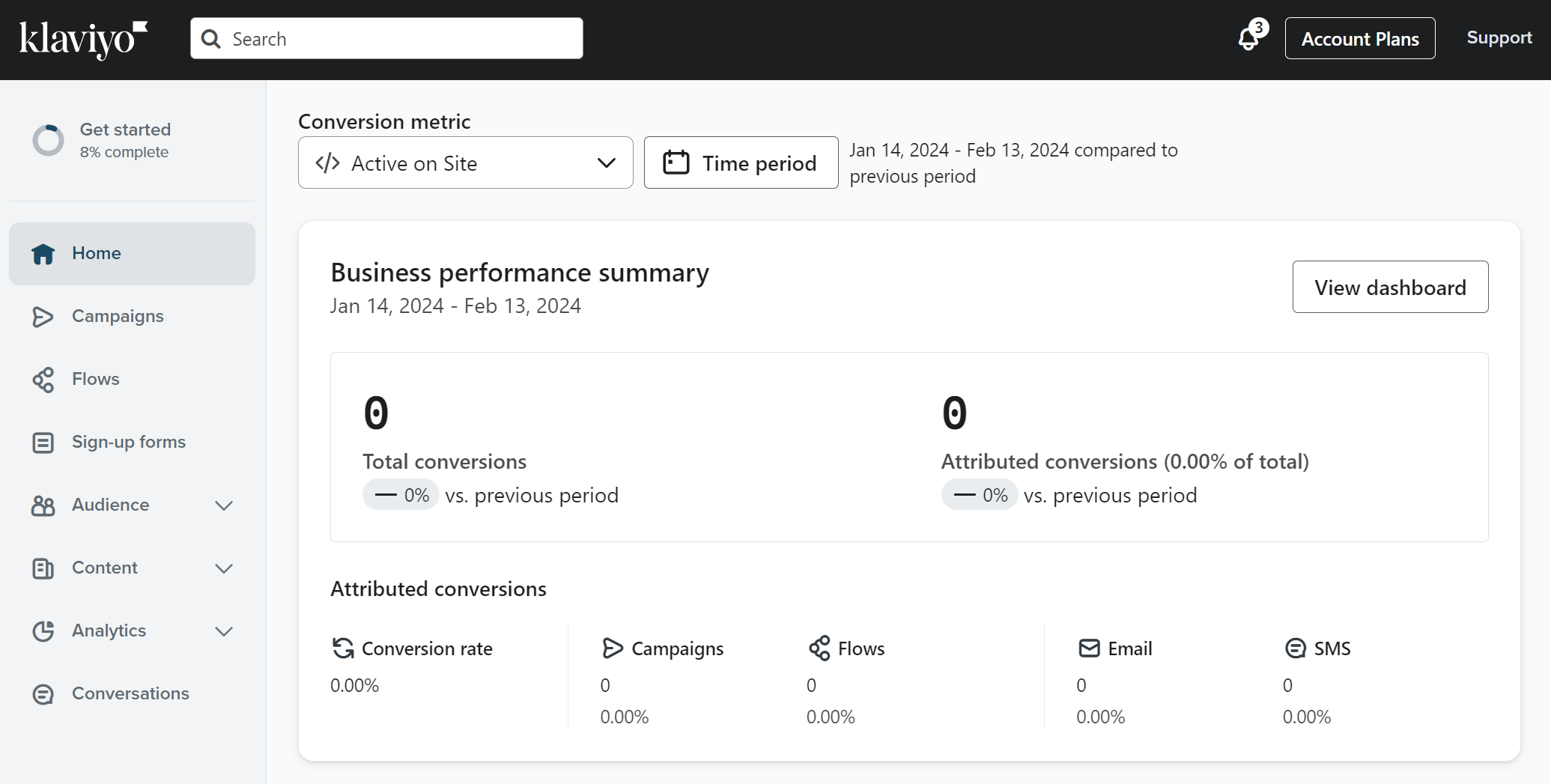
Klaviyo is built specifically for eCommerce, so setting it up starts with connecting your online store. It comes with deep integrations with platforms like Shopify, WooCommerce, BigCommerce, and Magento, and many of its features, like segmentation, product feeds, and revenue tracking, depend on this connection. Because of that, setup can be slow, especially for beginners.
The dashboard looks clean, but it can feel overwhelming at first because there’s a lot going on. That said, once you get familiar with the layout, it’s easy to create campaigns, build automations, and review analytics.
We also found that Klaviyo’s setup guides and onboarding documentation are helpful, but not as beginner-friendly as other platforms. If you’re new to email marketing or don’t have a technical background, expect a learning curve.
Still, the tradeoff is access to granular control and powerful features from the start, which is particularly valuable for eCommerce marketers who want more than just the basics.
Mailchimp:
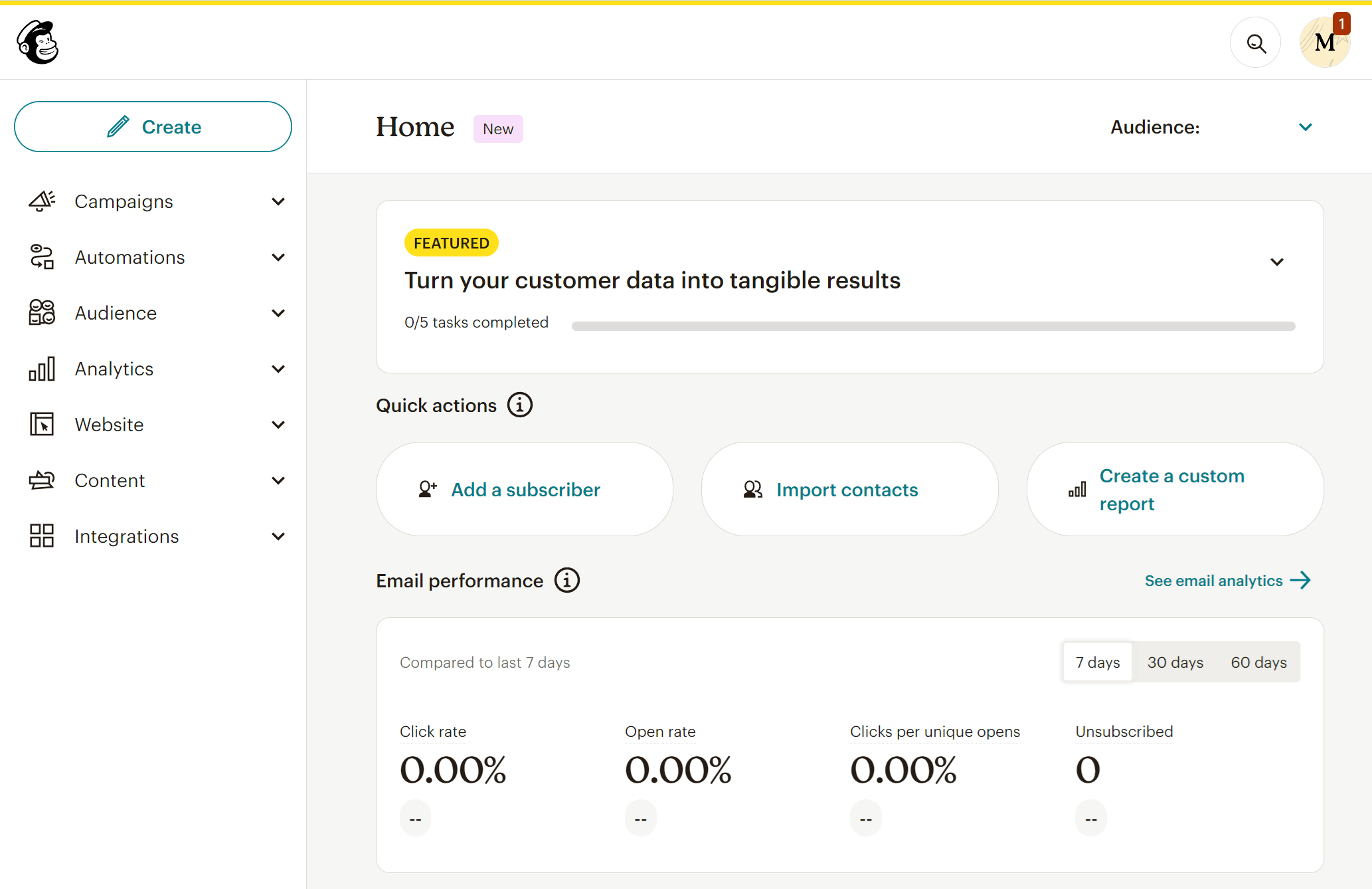
Signing up for Mailchimp is quick, and the platform provides a helpful onboarding flow that prompts users to define their goals, import contacts, and explore basic features like campaigns and automations.
For eCommerce users, Mailchimp integrates with platforms like Shopify (via third-party tools), WooCommerce, BigCommerce, and Squarespace. However, some of these integrations, especially Shopify, are not as seamless as what Klaviyo offers. You can sync product and customer data, but often you’ll need extra apps or workarounds to unlock all the features.
The dashboard is clean and well-organized, with a prominent “Create” button that lets users quickly launch a campaign, automation, or landing page. Once you get familiar with where things are, it’s pretty straightforward.
Still, the experience isn’t perfect for eCommerce users. Key tools like forms and landing pages are in separate sections and can be hard to find if you’re new to the platform. Additionally, Mailchimp doesn’t focus on eCommerce-specific features. You’ll find fewer built-in prompts for setting up revenue-based automations or product triggers unless you explore them manually.
That said, if you don’t want to dive deep into eCommerce data from the start, you’ll find that Mailchimp is easier to learn than Klaviyo. It’s a solid choice for smaller online stores or businesses that sell across multiple channels and want a flexible, general-purpose email platform.
Winner: Mailchimp takes the lead here, especially for new users. However, larger eCommerce brands may find its integrations and data handling less robust than Klaviyo’s.
Email Builder
Klaviyo:
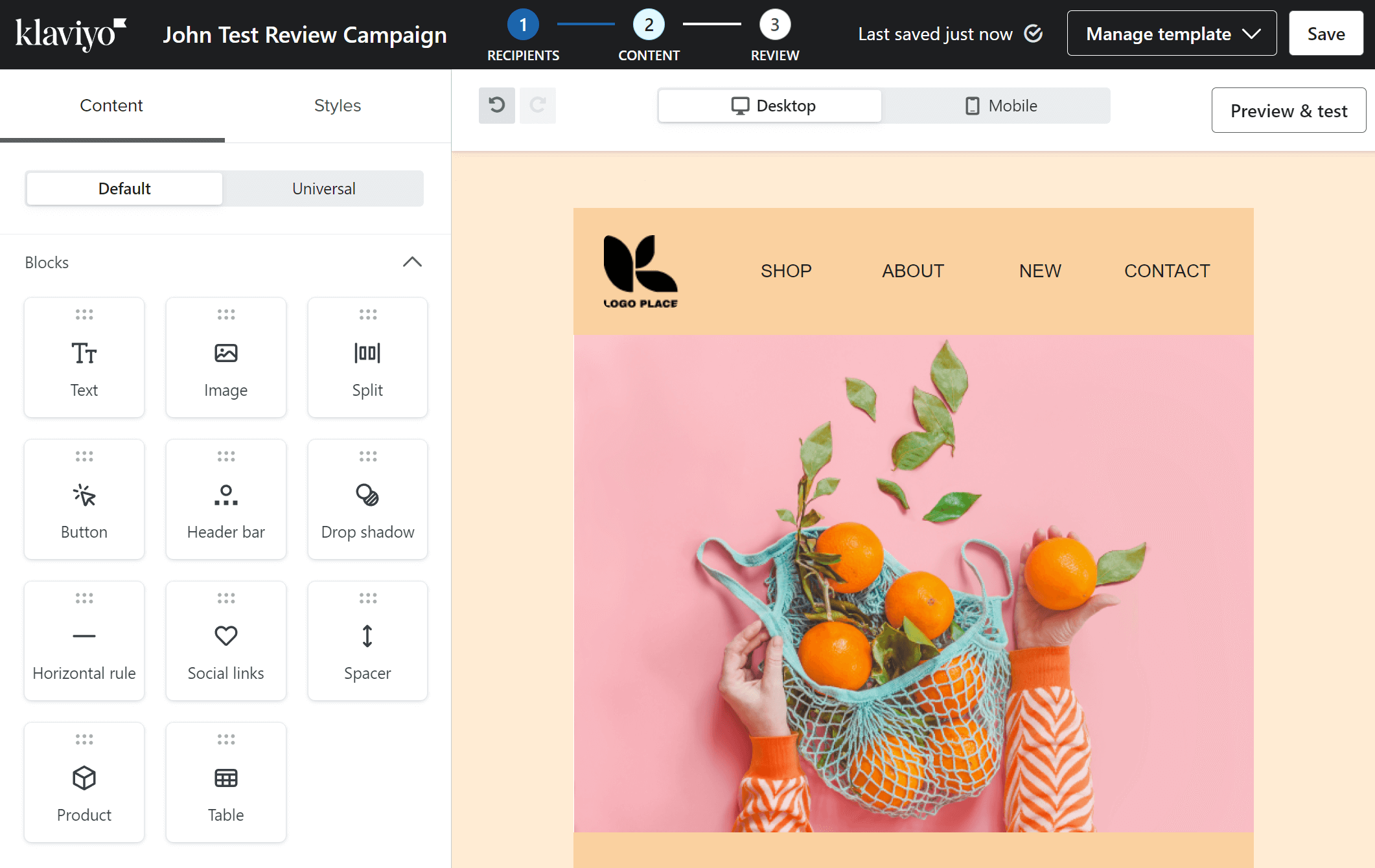
Klaviyo’s email builder is robust and clearly tailored to eCommerce businesses. It uses a modern drag-and-drop interface with a flexible content block system, making it easy to create emails that match your brand. You can send dynamic product recommendations, add personalized content, and run A/B tests—great for boosting sales.
One standout feature is the Product Block, which automatically pulls product images, names, and prices from your store. You can even filter products by category or show items based on what customers viewed or added to their cart, making emails feel more personal.
In our testing, we found the editor intuitive and responsive. It includes mobile previews, undo/redo functionality, and version history, which is helpful for complex campaigns. However, Klaviyo doesn’t have as many pre-built content blocks as other competitors, which might limit creativity.
Another strength is Klaviyo’s integration with brand assets. You can store logos, color palettes, and fonts to ensure design consistency across emails. Overall, it may not be the flashiest editor, but it’s efficient and built for personalized, data-driven marketing.
Mailchimp:
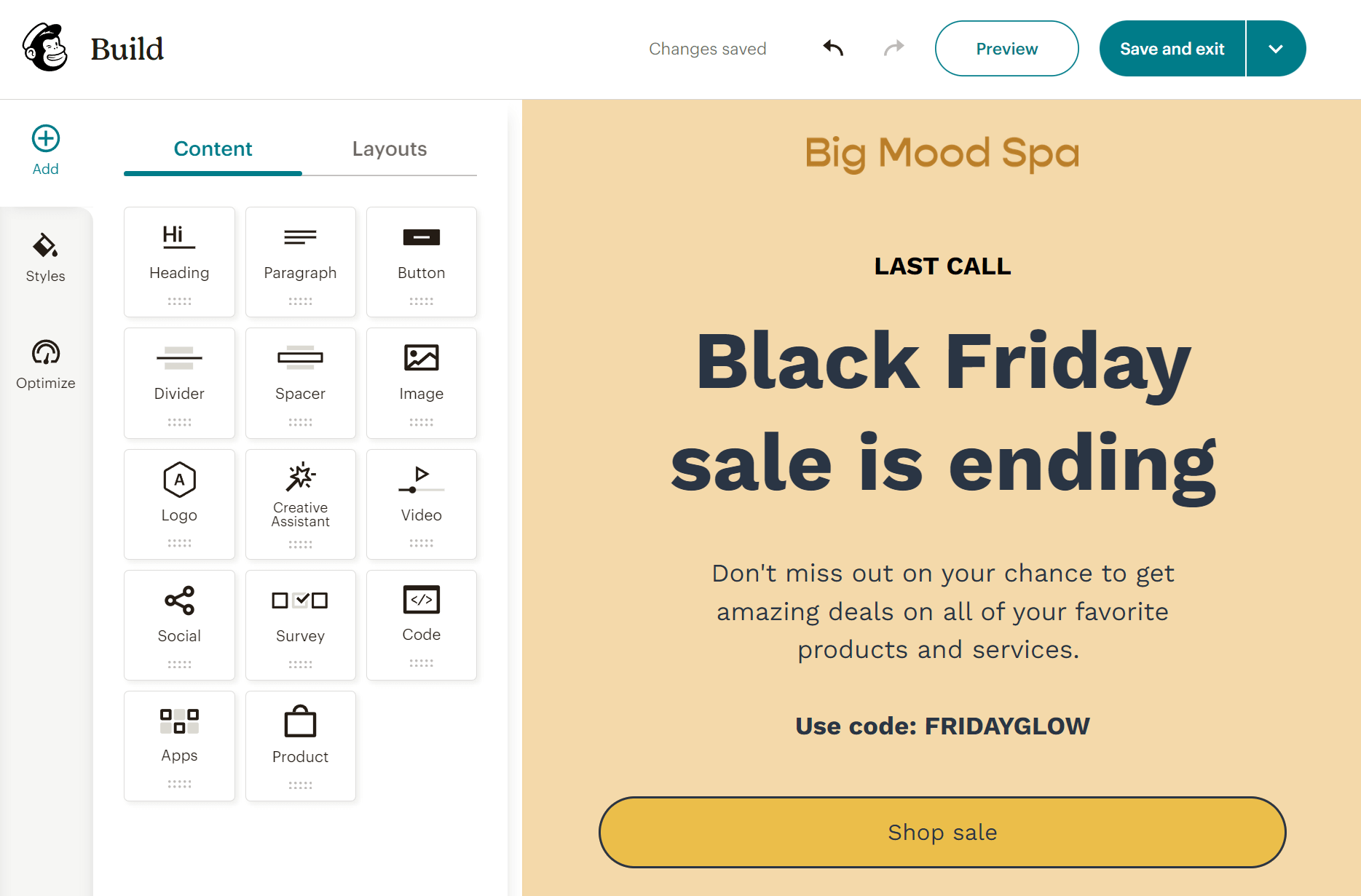
Like Klaviyo, Mailchimp’s email builder is drag-and-drop, with a clean and responsive interface. You can choose from a wide range of content blocks like text, image, video, buttons, product recommendations (if your store is connected), and even surveys.
With the Product block, you can feature items or auto-fill products, although this functionality isn’t quite as dynamic or customizable as Klaviyo’s. If you use Shopify, you’ll also be able to send product review requests.
Mailchimp’s builder includes a handy “Creative Assistant” that can generate designs based on your brand’s colors, logo, and style. This feature is useful for smaller eCommerce teams without in-house designers, although you’ll still need to manually adjust the results.
Another useful feature we found was the Content Studio. It stores all your images, files, and brand assets in one place. this way, you can easily reuse content for different campaigns, like seasonal sales or product launches.
The main downside of Mailchimp’s email editor is that there is no built-in version history. This can be a problem if multiple people are working on the same email.
Winner: Tie! Both email builders are great at creating eye-catching newsletters, no matter how experienced the user is.
Templates
Klaviyo:
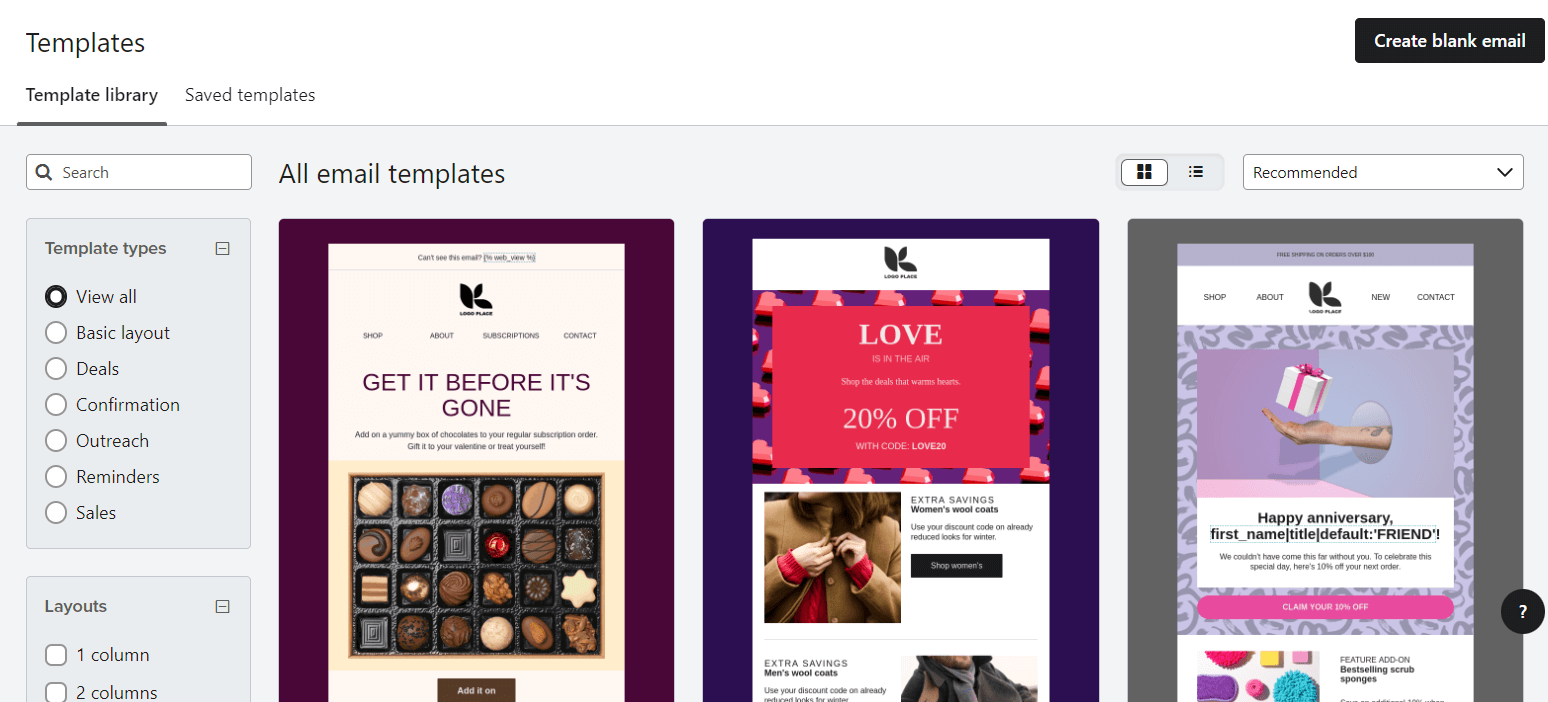
Klaviyo offers a decent collection of email marketing templates. Specifically, we found 110 aesthetic designs and 9 simpler ones. They can cover various goals such as sales, reminders, order confirmation, and deals. Overall, the quality is great, so eCommerce brands can quickly set up campaigns by customizing them.
These templates are also mobile optimized and highly customizable. This means you won’t need any HTML coding knowledge.
You can also effortlessly add brand assets such as logos, fonts, colors, etc. However, you’ll need to set them up in your account first before using them in your emails.
Mailchimp:
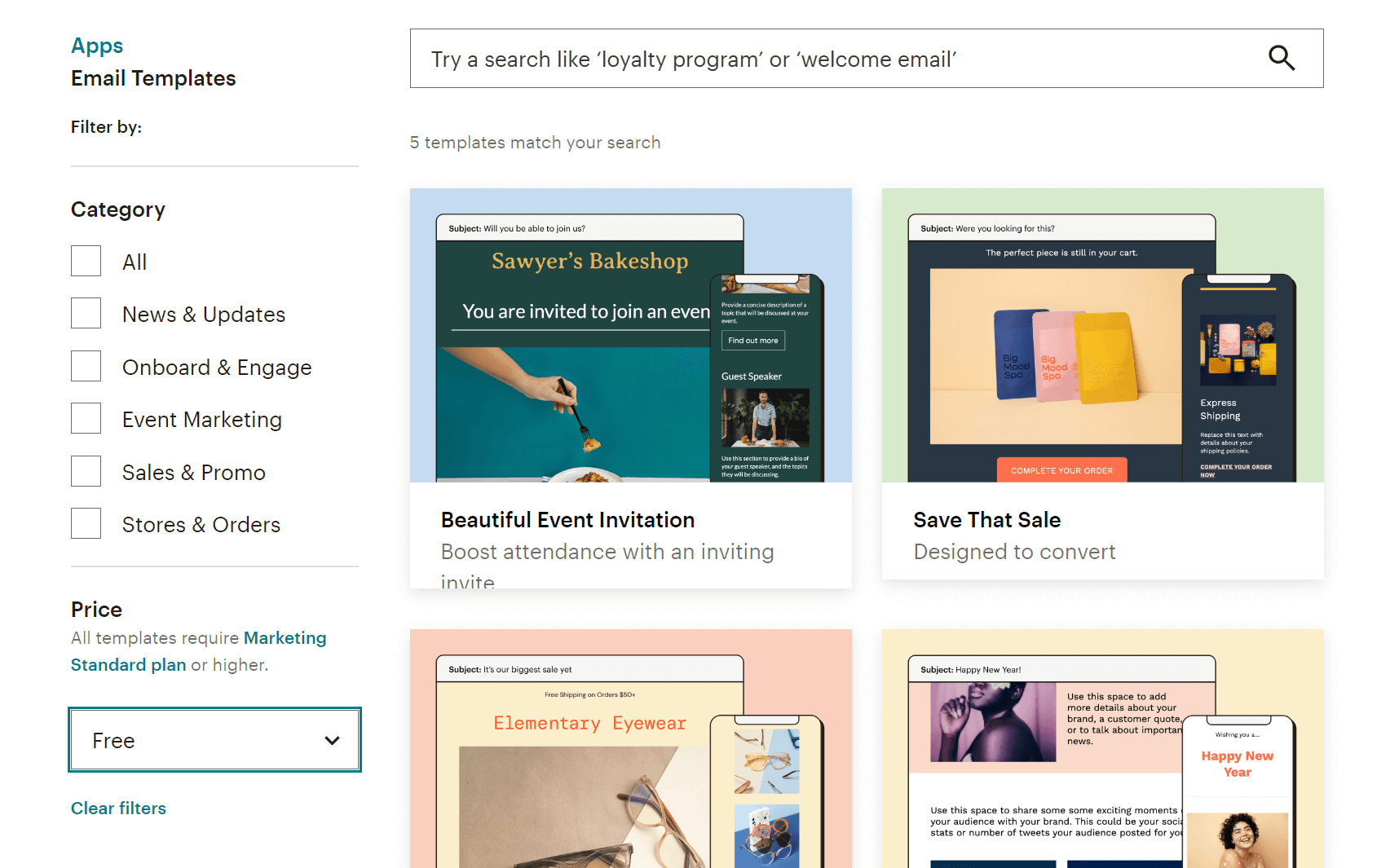
Mailchimp has an equally impressive library of email marketing templates. Its 135+ professionally designed newsletter templates are categorized for easier navigation. For instance, you can find designs for sales and promotions, order confirmation, onboarding, holiday messages, and company updates.
If you’re more advanced, you can also create custom HTML templates via code, a URL, or a ZIP file.
On the free plan, however, you only get access to 8 basic templates. To unlock the full library, you’ll need a paid plan. For eCommerce users, this limitation can be frustrating, especially when just starting out.
Overall, Mailchimp’s template library is broad and visually diverse, which is a plus for marketers who value design flexibility
Winner: Mailchimp. While Klaviyo’s templates are better optimized for data-driven, eCommerce-focused campaigns, Mailchimp offers better design variety and quick customization.
Marketing Automation
Klaviyo:

Automation is one of Klaviyo’s biggest strengths. Its powerful visual flow builder lets you create fully customized customer journeys based on real-time actions. Automations are called “flows,” and they include a wide range of 60+ pre-built options like abandoned cart, welcome series, post-purchase, product browse abandonment, and win-back sequences.
What sets Klaviyo apart is its deep data integration with eCommerce platforms. You can trigger emails based on highly specific customer actions, e.g., viewed a product, placed an order, added to cart, canceled a purchase, joined a segment, and much more. Flows can also include conditional logic, delays, splits, A/B testing, and multichannel elements like SMS and mobile push notifications, all within the same automation.
What’s also nice is that every part of the workflow is transparent. You can see how many recipients are in each stage and track performance by open rate, click-through, and revenue generated.
A new feature, “Flows AI,” functionality, makes setup even faster. You simply describe what you want, and Klaviyo’s AI creates the structure for your entire flow.
Mailchimp:
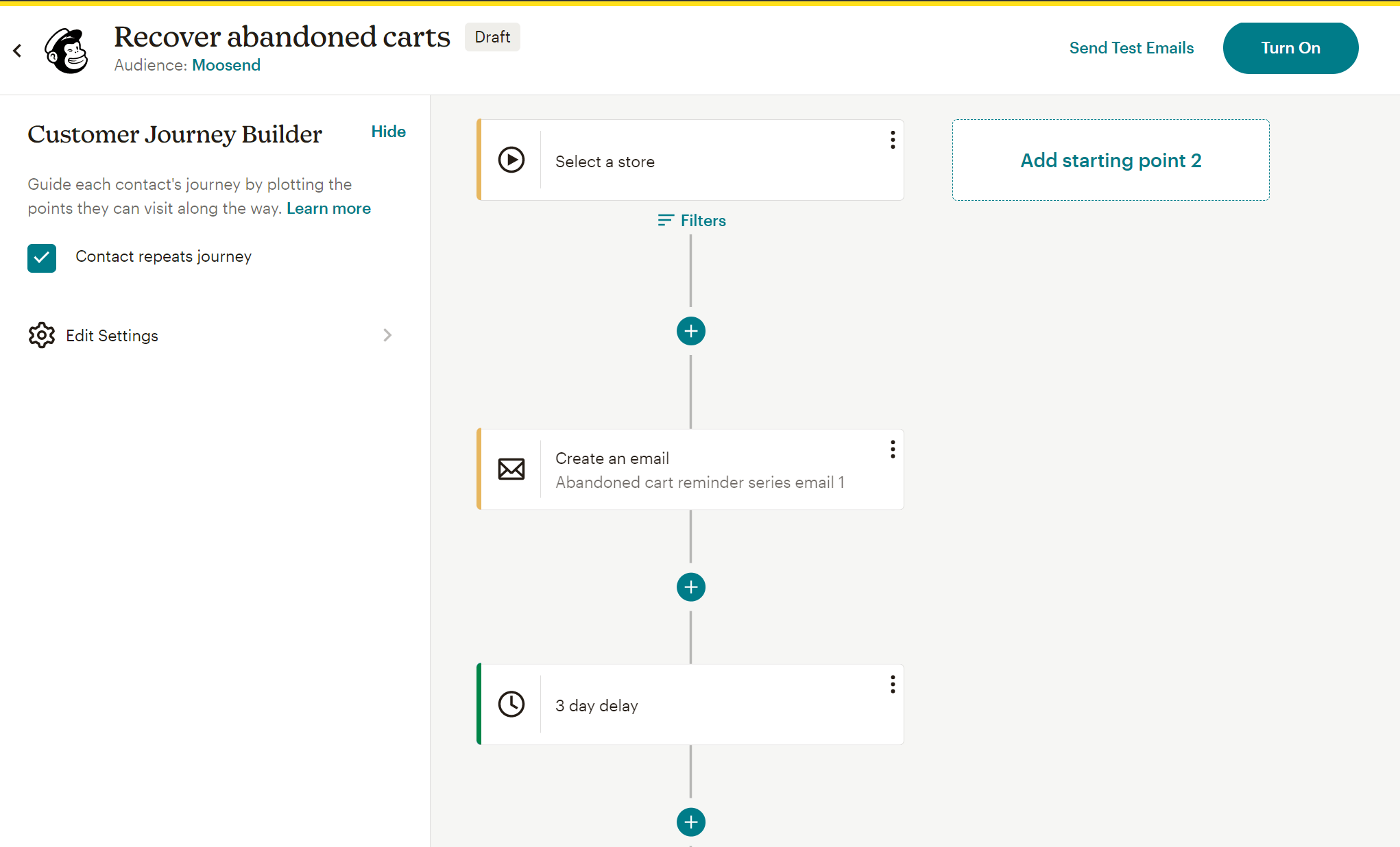
Mailchimp comes with a powerful visual workflow editor called Customer Journey Builder. It lets you create simple and sophisticated automated sequences using triggers like signup, email activity, or basic purchase behavior.
You’ll find over 100 pre-built automations, including welcome emails, order notifications, and limited post-purchase flows. However, most of these automations are email-only. SMS and transactional messaging require third-party integrations, and there’s no native support for push notifications.
Mailchimp includes branching logic and A/B testing within automations, but it lacks the depth of behavioral triggers found in Klaviyo. For example, you can’t easily set up a browse abandonment flow based on a specific product page view unless additional tracking is set up manually.
Winner: Klaviyo wins this round. Its automation features are more advanced, more customizable, and far better suited for eCommerce.
List Management
Klaviyo:
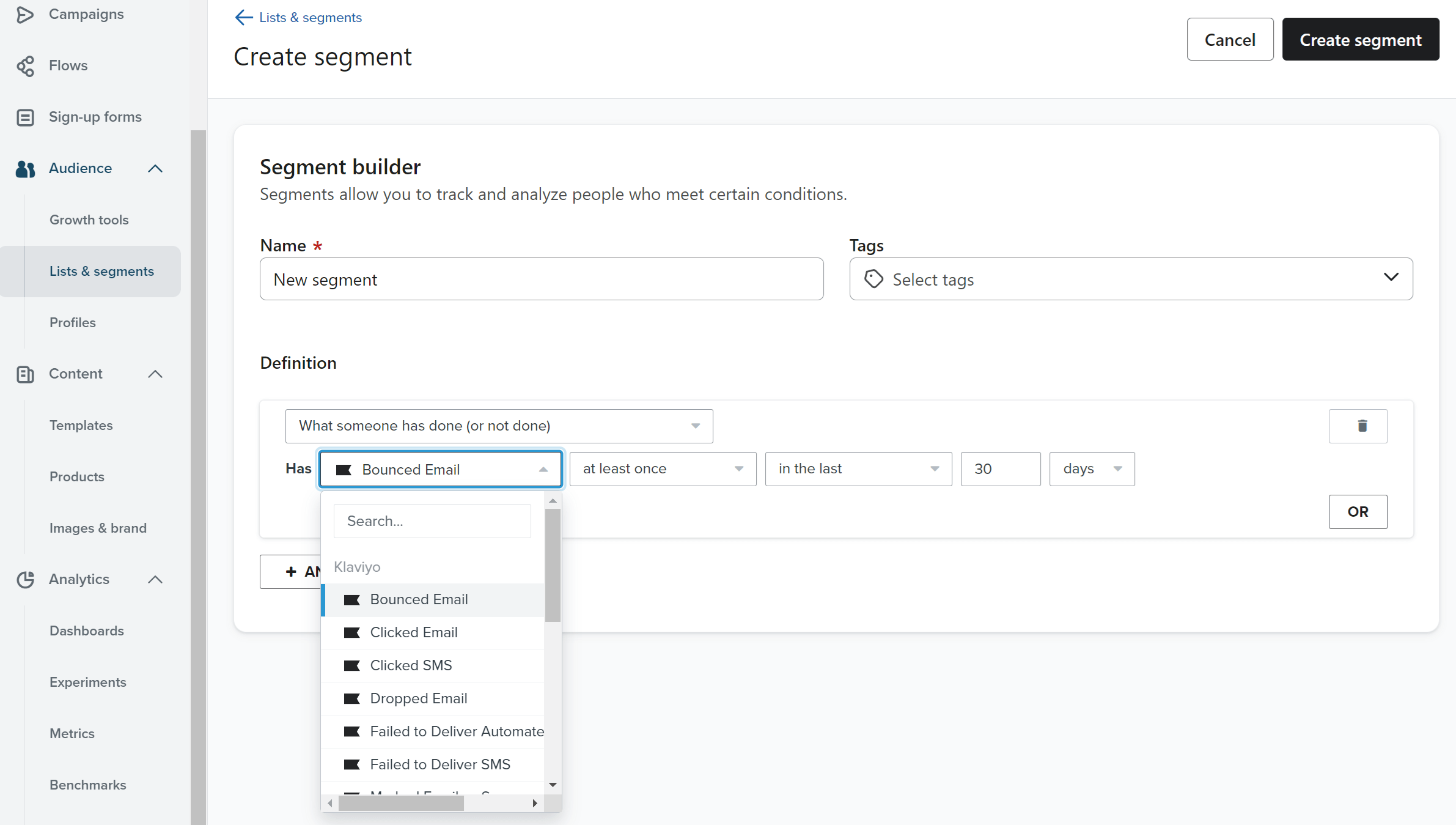
We found that Klaviyo’s segmentation is a strong asset for eCommerce brands. You can use data from your store (like purchase history, product views, average order value, or time since last purchase) to build real-time segments. These segments update dynamically as customer behavior changes, and there’s no limit to how many you can create.
You can segment customers based on:
- Behavioral triggers (viewed product, added to cart, placed order)
- Predictive metrics (churn risk, next order date)
- Demographics and custom fields
- Engagement (email opens, clicks, inactivity)
Klaviyo’s lists are static and good for controlled sending (e.g., welcome series), while segments are dynamic and ideal for automations and targeting high-value shoppers.
Another helpful feature: Klaviyo estimates Customer Lifetime Value (CLV) and shows lifecycle stages, helping you identify loyal customers, slipping buyers, or one-time shoppers and trigger messaging accordingly.
Mailchimp:
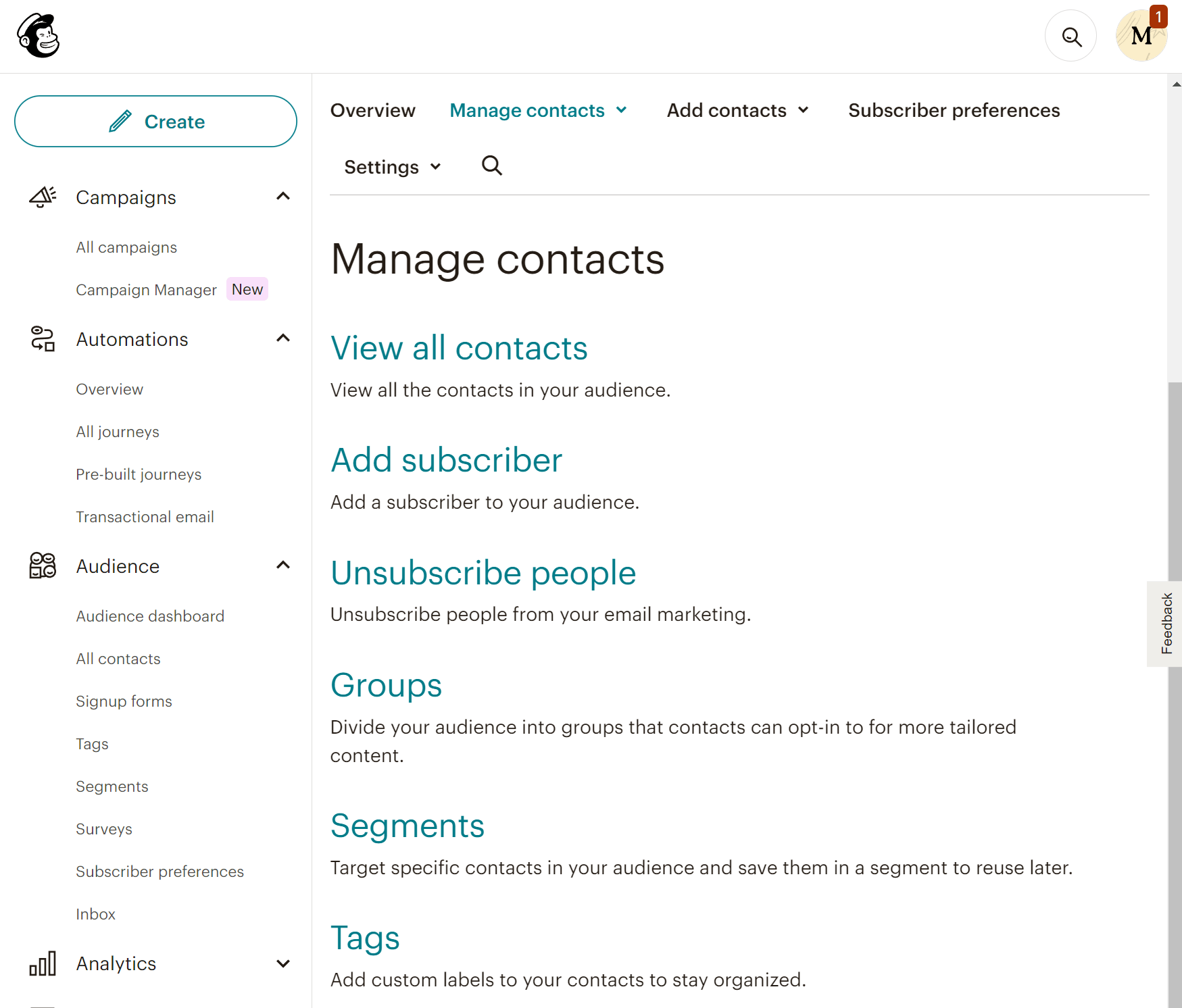
Mailchimp offers a good range of list management tools, but it works differently from Klaviyo. You can manage contacts using Audiences (lists), and if the same contact appears in multiple audiences, you’re charged multiple times. This is a major drawback for growing eCommerce brands.
Segmentation is done through:
- Tags (manual labels)
- Groups (subscriber-managed categories)
- Segments (based on behavior or profile data)
You can segment by purchase activity, campaign engagement, demographics, and location. With the right integrations, you can segment by product interest or cart abandonment, too, but these features are limited on the free and Essentials plans.
Compared to Klaviyo, Mailchimp’s segmentation lacks real-time updates and granularity. Also, the UI for managing audiences, tags, and segments can be confusing for new users, especially when scaling campaigns across product lines.
Winner: Klaviyo wins this round thanks to its real-time, behavior-based segmentation and deep eCommerce integration.
Reporting & Analytics
Klaviyo:
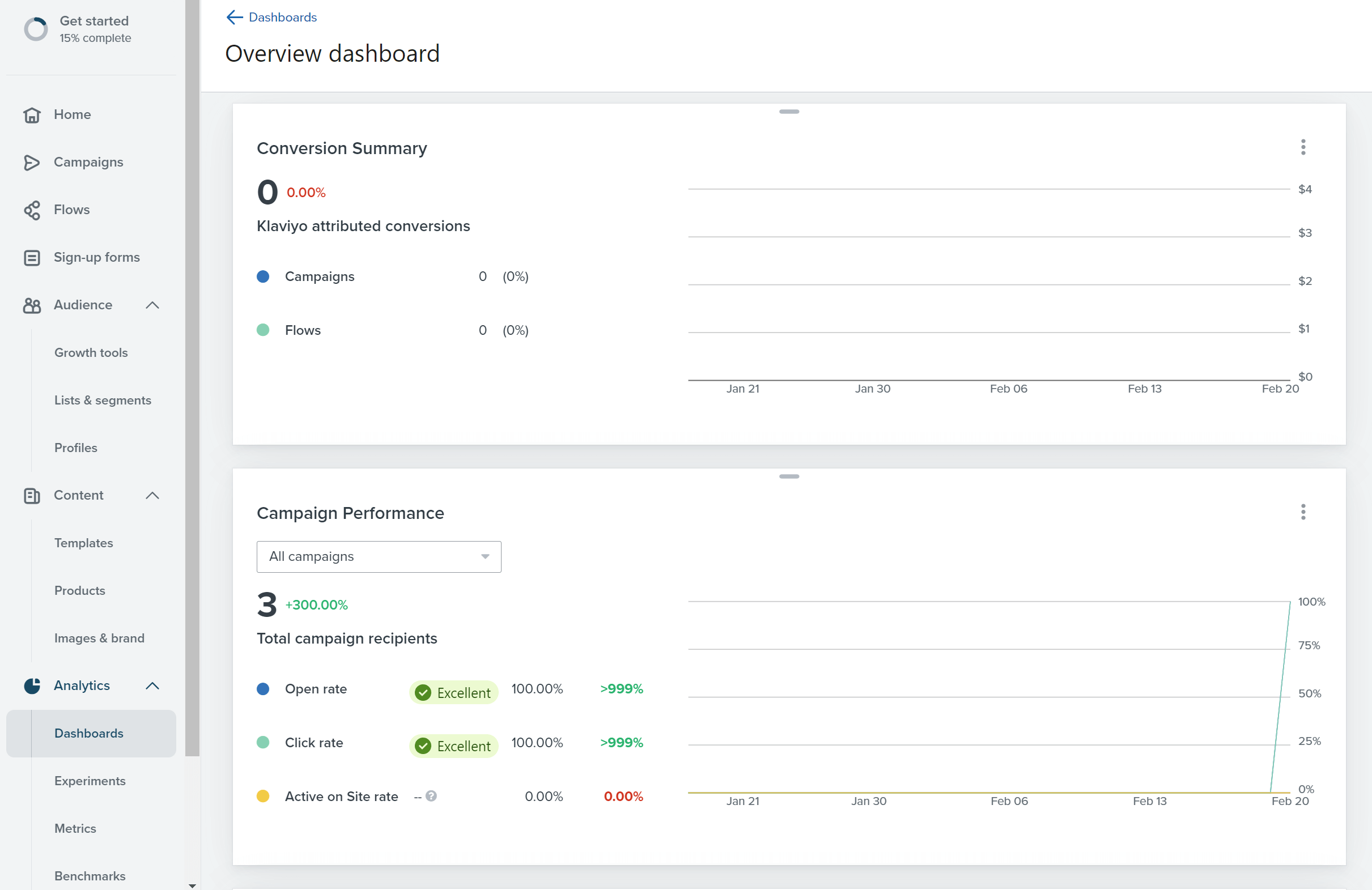
Klaviyo’s reporting is deeply tied to eCommerce performance, making it easy to track not just email metrics but real revenue impact. The dashboard gives you immediate insight into how much money each campaign, flow, or automation generates, along with standard KPIs like open rates, click rates, and conversion metrics.
Key analytics features include:
- Revenue attribution per campaign and flow
- Product performance reports
- A/B testing for both campaigns and flows
- Custom report builder (on higher plans)
- Predictive analytics (CLV, churn risk, next order date)
You can drill down into individual customer profiles to see how they interact with your brand, which campaigns influenced their purchases, and where they are in the customer lifecycle.
What sets Klaviyo apart is how seamlessly this data connects to segmentation and automation, allowing you to act on insights immediately, rather than just look at numbers. It’s a great tool for data-driven marketers.
Mailchimp:
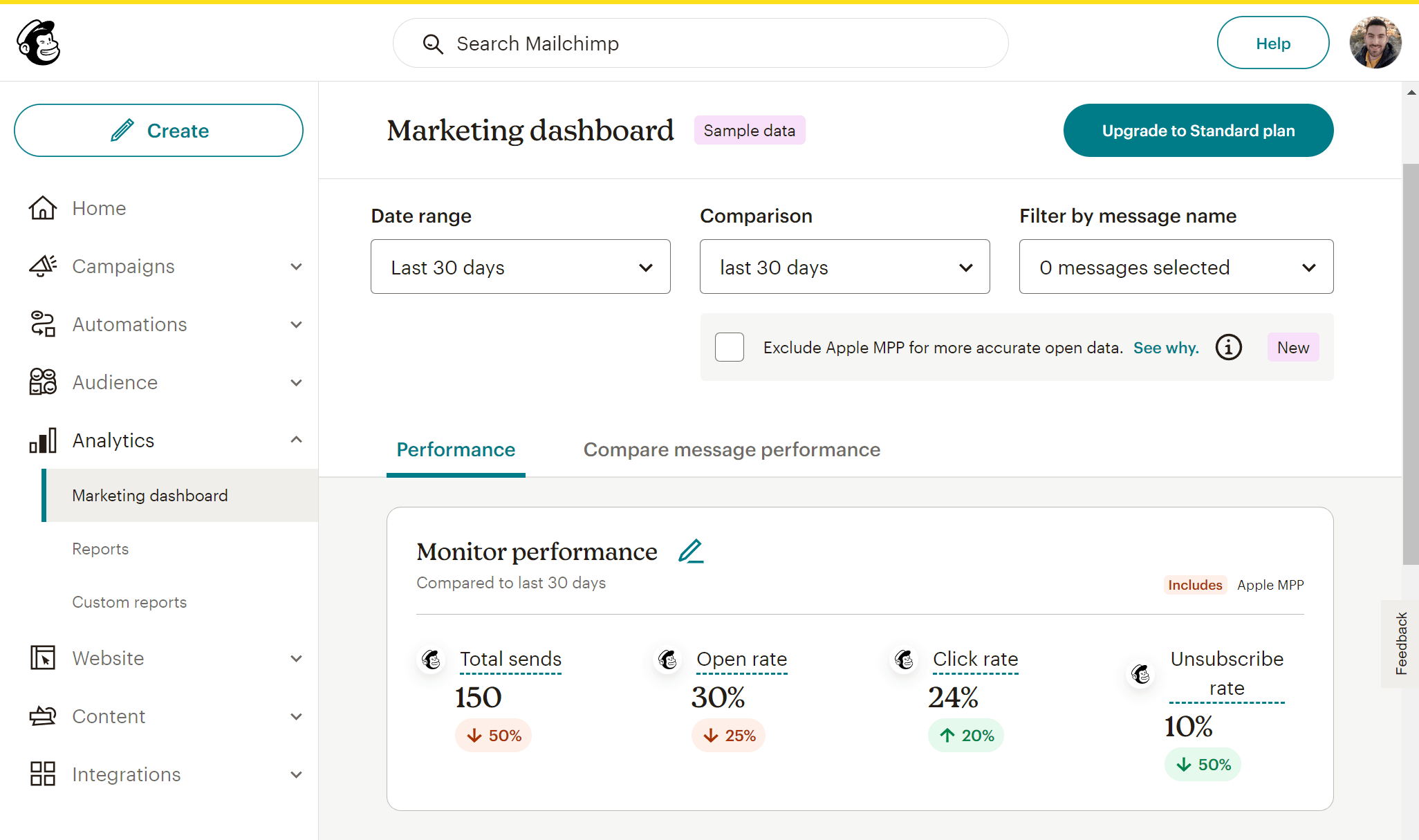
Mailchimp offers clear, easy-to-use reports with all the basics, like open rates, clicks, bounces, unsubscribes, and email engagement over time. You can also compare how different campaigns perform with its comparative report feature.
For eCommerce users, Mailchimp shows:
- Basic sales tracking (if your store is connected)
- Product-level reporting
- Revenue from individual campaigns
However, its revenue attribution isn’t as precise or detailed as Klaviyo’s. You can track total revenue generated, but it’s harder to understand how specific campaigns or automations influence customer behavior over time.
Overall, Mailchimp’s reporting is more focused on campaign-level insights, rather than the full eCommerce journey.
Winner: Klaviyo. It is built to tie every campaign and automation back to revenue.
Forms & Landing Pages
Klaviyo:
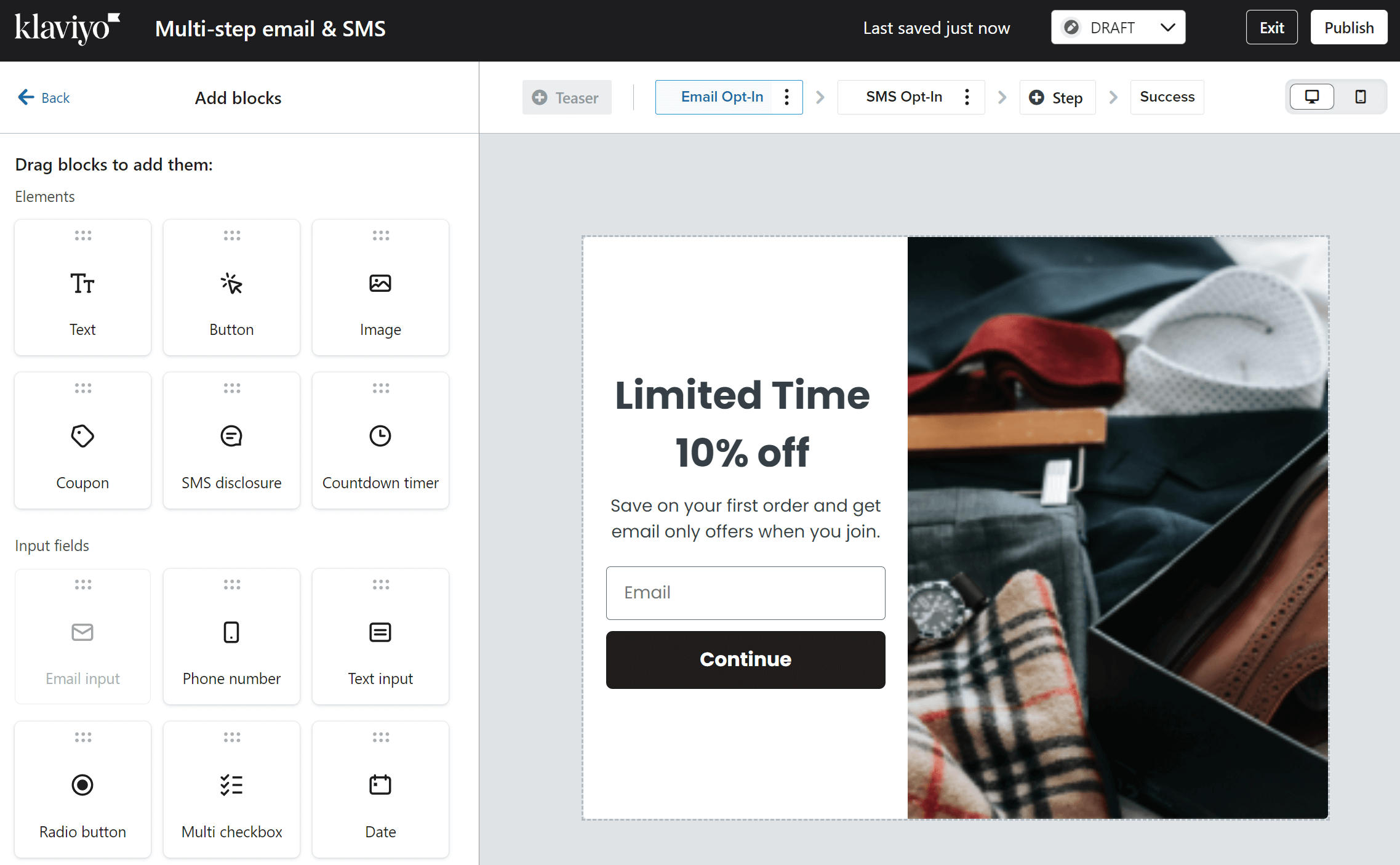
Klaviyo offers various customizable forms designed specifically for eCommerce lead generation. You can build popups, flyouts, embedded forms, as well as full-page forms. These are triggered by behavior (e.g., exit intent, scroll depth, time on page) and can include targeted messaging based on URL, device type, or user location.
Forms are fully customizable and support conditional logic. This allows merchants to tailor messaging to different segments, such as showing a discount popup to first-time visitors and hiding it from returning customers.
Klaviyo also supports multi-step forms, useful for gathering detailed information without overwhelming users upfront. Plus, any form can directly trigger an automation flow, like a welcome series or cart reminder.
The main drawback? Klaviyo doesn’t offer a landing page builder. While you can create “pages” using hosted forms, these are basic and primarily used for email capture. You won’t find advanced landing page features like product blocks, multi-column layouts, or checkout support.
Mailchimp:
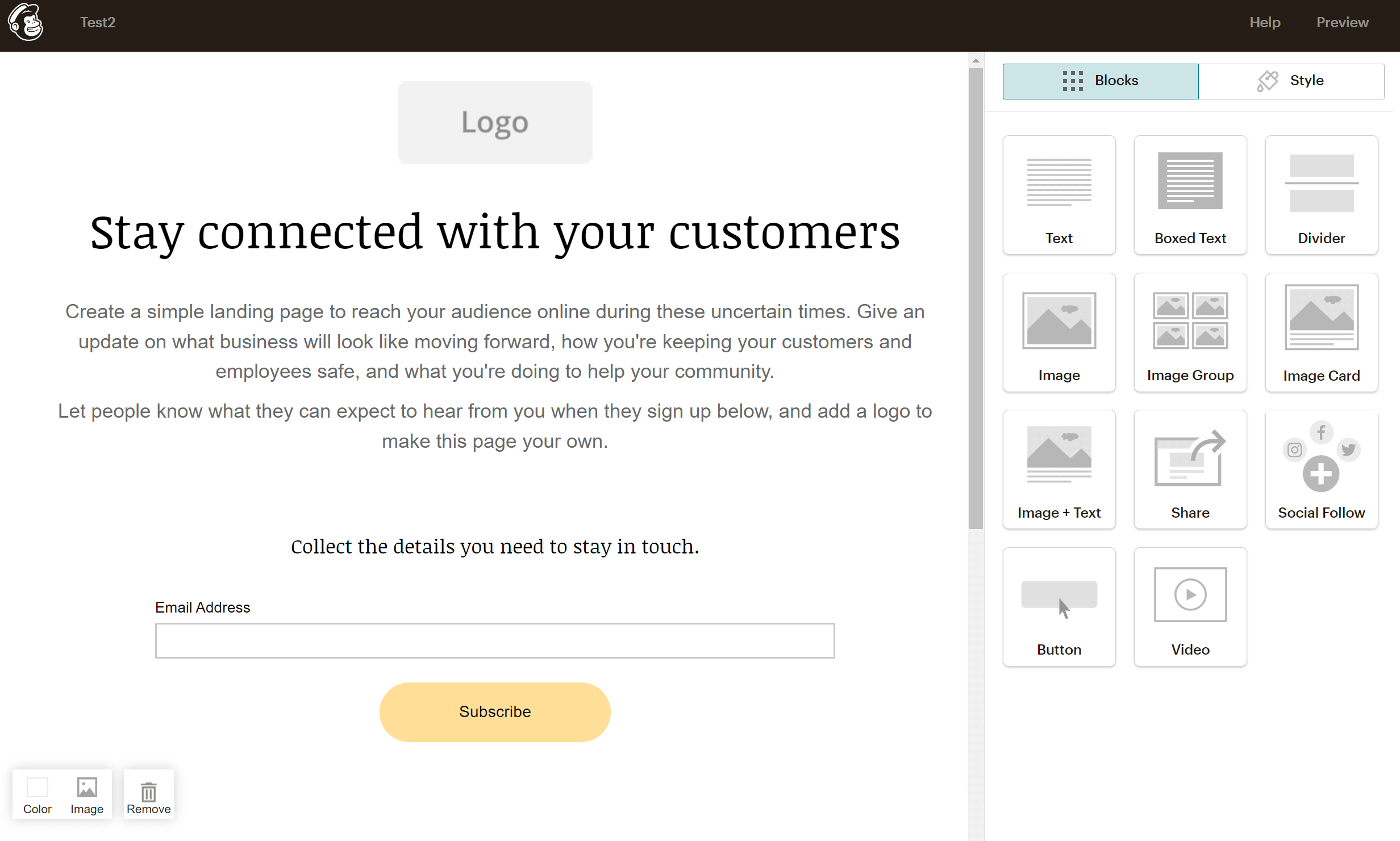
Mailchimp has both a form and a landing page builder tool, ideal for users seeking built-in versatility. With Mailchimp, you can build embedded signup forms, pop-up forms, contact forms, and full-featured landing pages.
The drag-and-drop landing page builder is easy to use and lets you design standalone pages for promotions, product launches, or lead generation campaigns. You caneven include buy buttons or product recommendations if your store is connected.
Mailchimp also supports GDPR-friendly forms, conditional fields, and social sharing options. While the form builder itself looks quite basic, it’ll cover most of your needs.
One limitation is that deeper behavioral targeting in forms requires manual setup, and the platform doesn’t support multi-step forms natively. Still, Mailchimp is a strong choice if you want to run quick promotions or grow your list through standalone pages.
Winner: Despite Klaviyo’s form targeting and segmentation being more advanced, Mailchimp is a more complete solution.
Klaviyo vs Mailchimp: Integrations
Klaviyo:
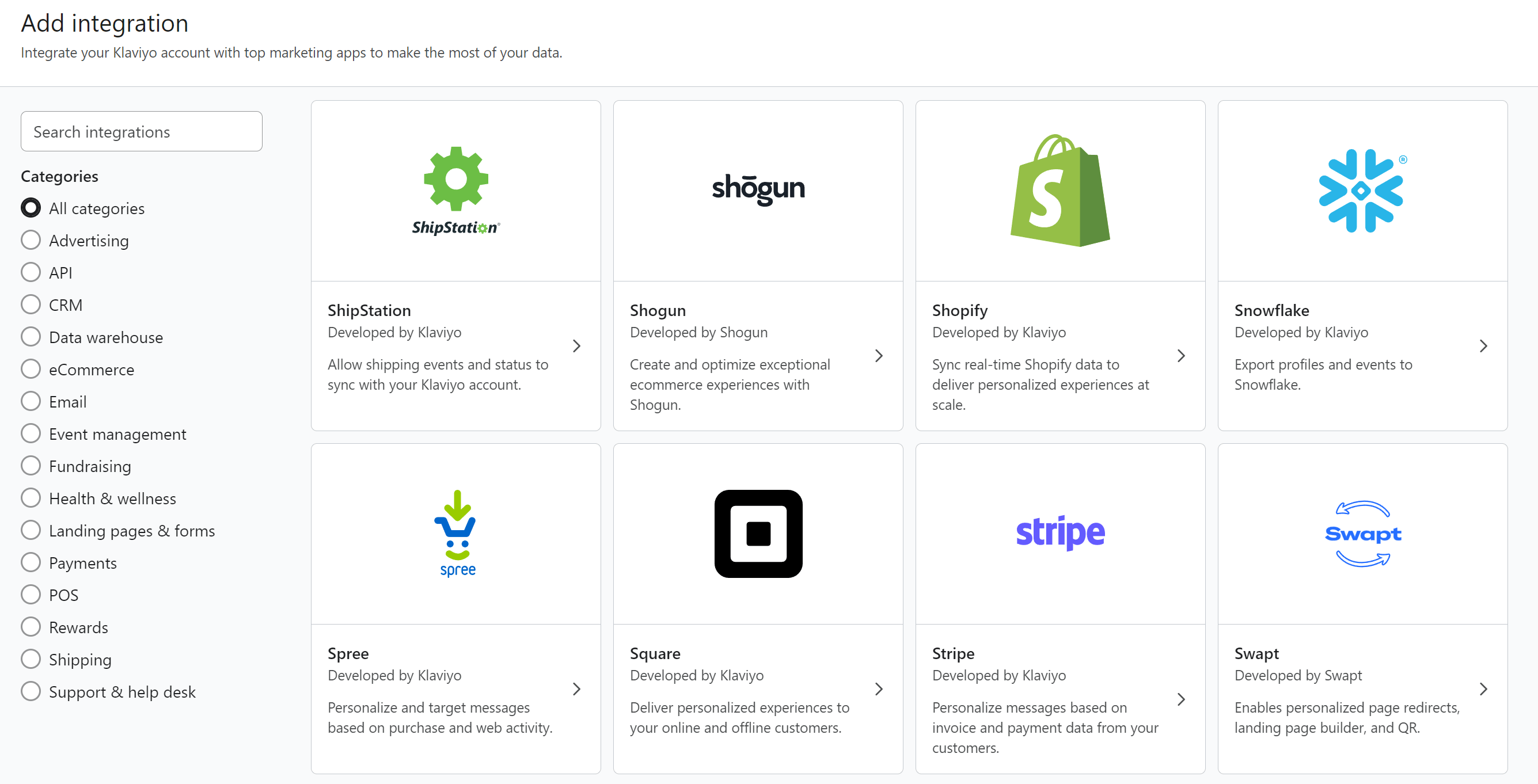
This eCommerce email marketing service offers more than 360 integrations. It connects natively with platforms such as Shopify, BigCommerce, WooCommerce, Magento, and Salesforce Commerce Cloud. Its Shopify integration stands out because it allows Klaviyo to sync customer profiles, order history, product catalogs, and behavioral data in real time.
Beyond these, Klaviyo integrates with tools for subscriptions, loyalty programs, user-generated content, and SMS marketing. For example, it integrates with services like Recharge, Smile.io, and Yotpo. These integrations don’t just transfer data; they enhance it, allowing for personalized, performance-driven marketing campaigns.
For brands with more complex needs, Klaviyo also supports custom API integrations and works well with Zapier and webhooks, offering flexibility for technical teams.
Mailchimp:
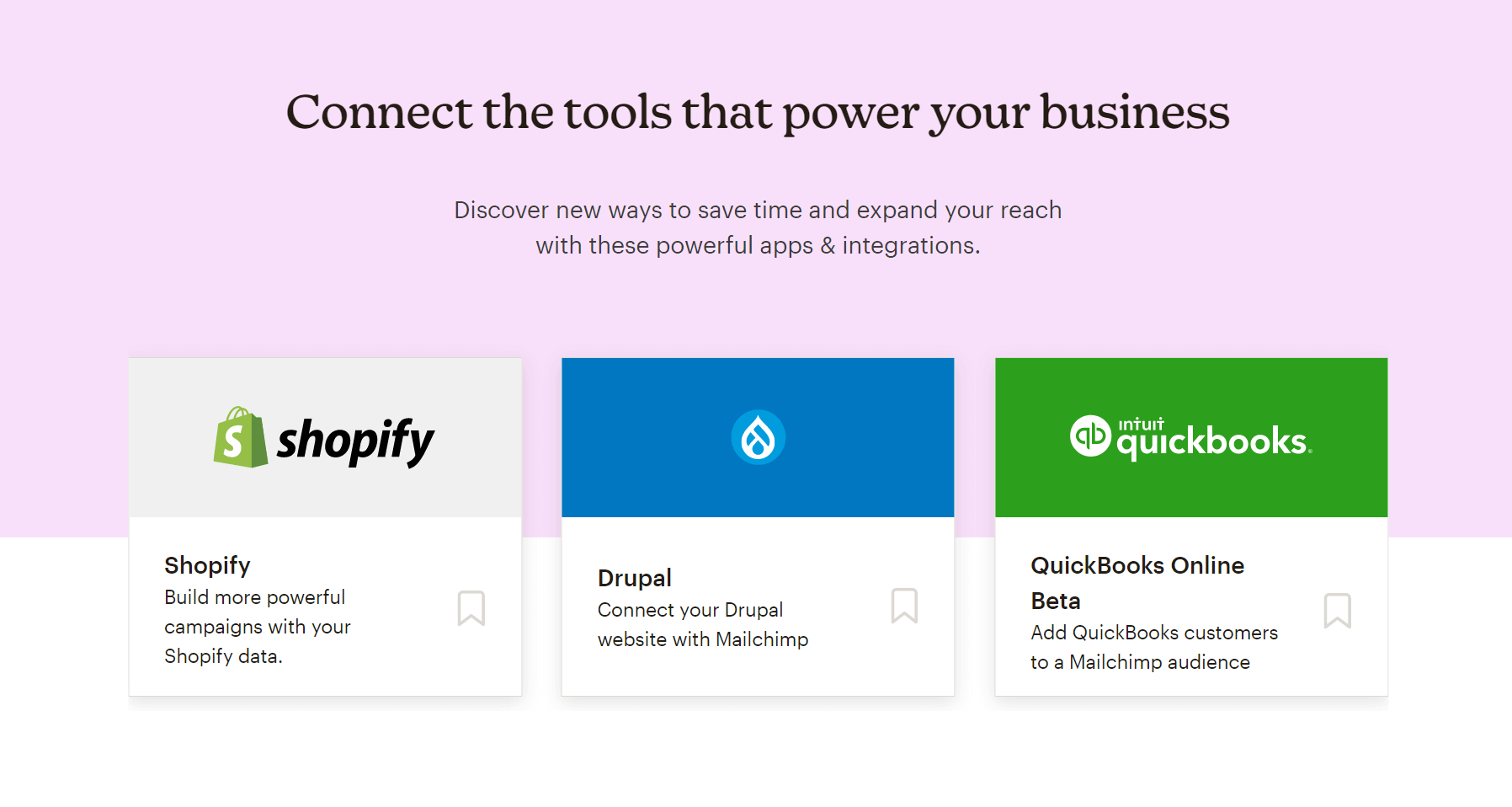
Mailchimpoffers over 330 integrations across categories like eCommerce, CRM, accounting, surveys, and social media. It works well with WooCommerce, BigCommerce, Squarespace, Stripe, QuickBooks, Salesforce, and many more.
However, the native integration with Shopify was discontinued, and users now have to rely on third-party solutions like ShopSync. This added step weakens the connection and can limit access to critical eCommerce features such as real-time product syncing or personalized product blocks.
While Mailchimp offers a broad list of integrations, the integration with eCommerce tools is limited. Mailchimp can sync basic data like purchase history or cart activity, but it lacks the behavioral triggers and real-time customer insights that Klaviyo is built around.
Winner: Klaviyo. Its integrations are built not just to connect, but to enrich customer data and power more sophisticated targeting and automation.
Klaviyo vs Mailchimp: Customer Support
Klaviyo:
This eCommerce email marketing platform offers a comprehensive help center with guides, tutorials, and webinars that cover both basic setup and more advanced strategies. For direct assistance, you can use Klaviyo’s live chat (Monday to Friday, business hours) and email support (7 days a week). However, free plan users only get email support for the first 60 days.
What stands out is the quality of Klaviyo’s support for eCommerce-specific issues. Their agents are generally knowledgeable about integrations with platforms like Shopify and BigCommerce, and can troubleshoot issues with data sync, automation flows, and performance tracking. While there’s no phone support, we found the chat responses quick and helpful. Larger businesses on custom pricing plans can also get a dedicated account manager.
Mailchimp:
Mailchimp’s support varies significantly depending on your pricing plan. Free users only get email support for the first 30 days. Then, they must rely on self-service resources like the help center and tutorials. Paid plans unlock additional support channels. Specifically, Essentials and Standard users get 24/7 email and live chat, while Premium users also get phone support and priority access.
While Mailchimp’s knowledge base is detailed and covers most features, many users report that wait times can be long, particularly during high-demand periods. Additionally, for eCommerce-specific questions, such as issues with third-party integrations or automation setup, Mailchimp’s support tends to be more general than Klaviyo’s.
Winner: Klaviyo. Their support team seems more equipped to handle eCommerce-related issues.
Klaviyo vs Mailchimp: Pricing
Now let’s compare the pricing of the two competitors.
Klaviyo:
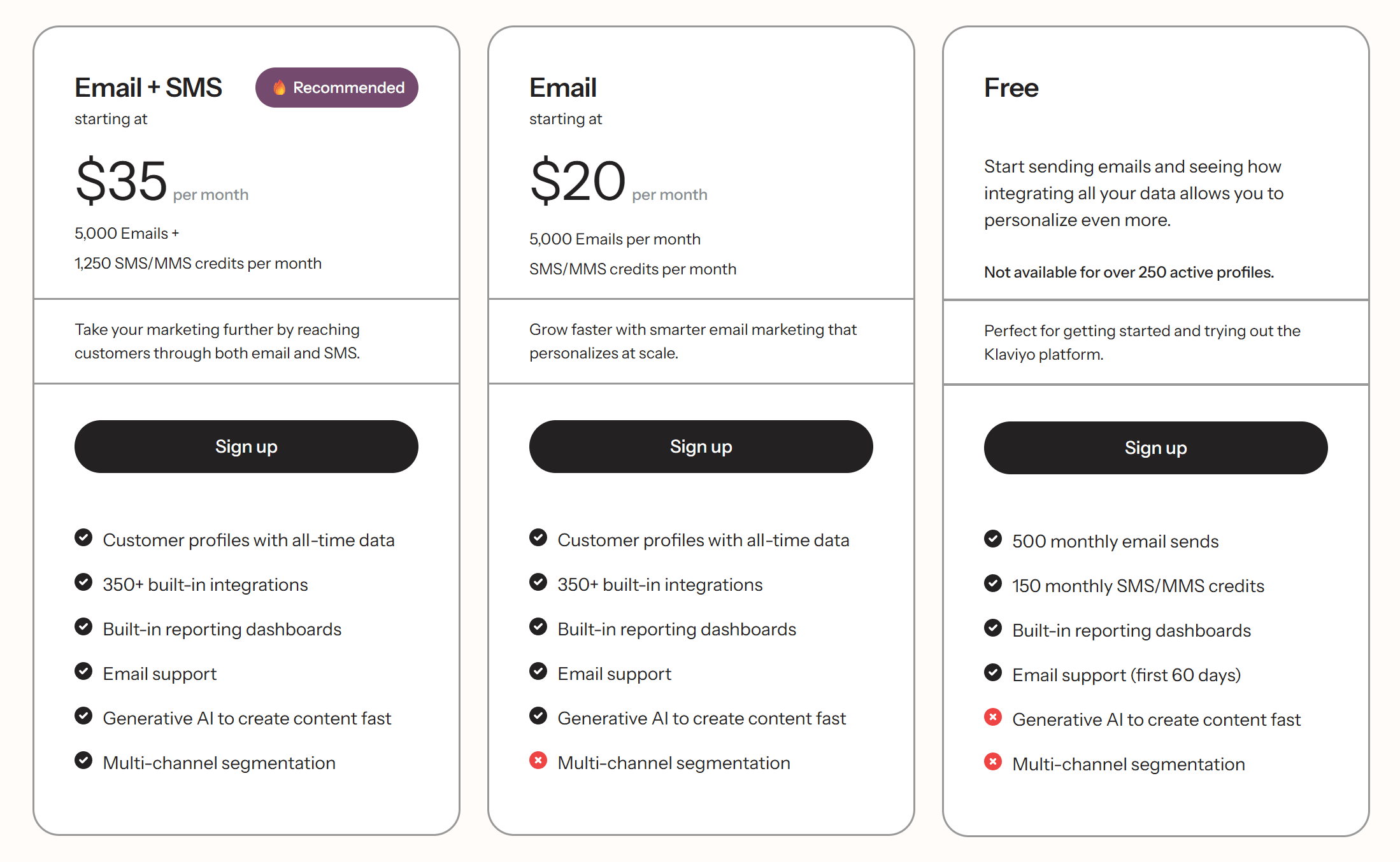
Klaviyo’s pricing is based on the number of active contacts, with both email and SMS options available. The free plan includes up to 250 active profiles and 500 monthly email sends, along with access to basic features like automation, segmentation, and forms.
Paid plans start at $20/month for up to 500 contacts, with pricing increasing as your list grows. SMS is billed separately, and you pay for what you use. Klaviyo’s pricing can scale quickly for larger lists, but the value is justified if you’re using its advanced automation, analytics, and revenue-tracking features to drive sales.
Mailchimp:
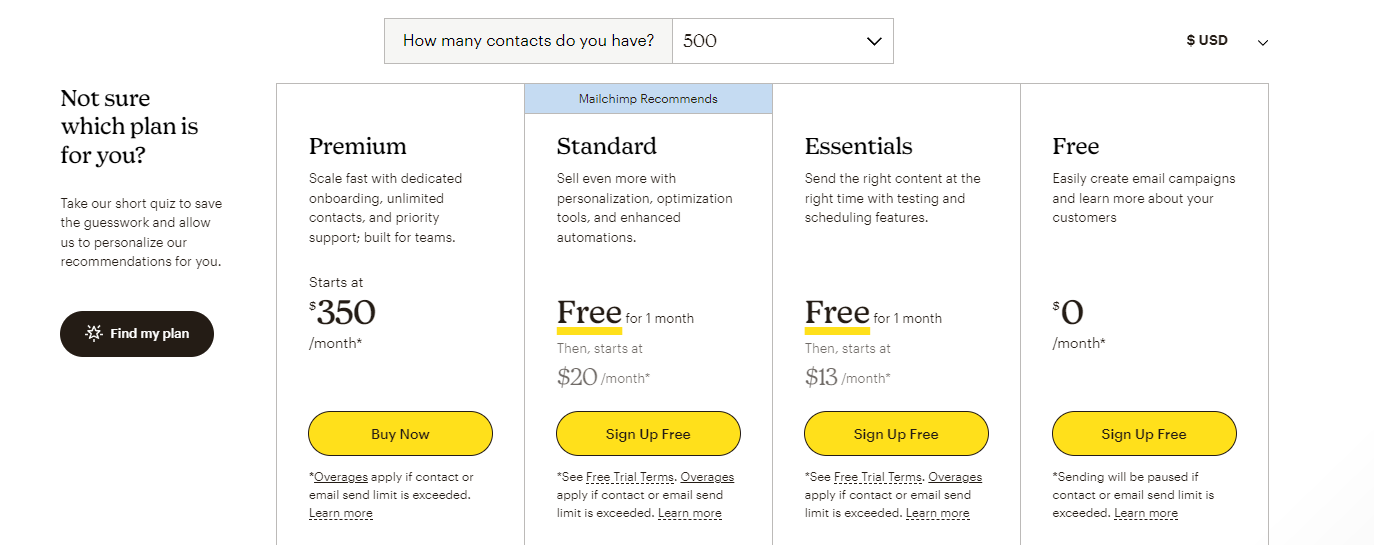
Mailchimp also offers a free plan, allowing up to 500 contacts and 1,000 monthly sends. However, many useful features such as email scheduling, A/B testing, and advanced segmentation are locked behind paid tiers.
The Essentials plan starts at $13/month for 500 contacts, but you’ll need to move up to Standard or Premium to access more robust automation, dynamic content, and analytics. Mailchimp’s pricing is flexible for basic needs, but eCommerce brands that need advanced features will find it less cost-effective. Additionally, Mailchimp charges for duplicate contacts across different audiences, which can increase your costs as your list grows.
Winner: While Mailchimp might be slightly more affordable for high-volume senders, Klaviyo wins this round due to its straightforward and transparent pricing.
Top Klaviyo and Mailchimp Alternatives
If you’re unsure about Klaviyo and Mailchimp or you want to explore more alternative options, here are the top solutions.
1. Moosend
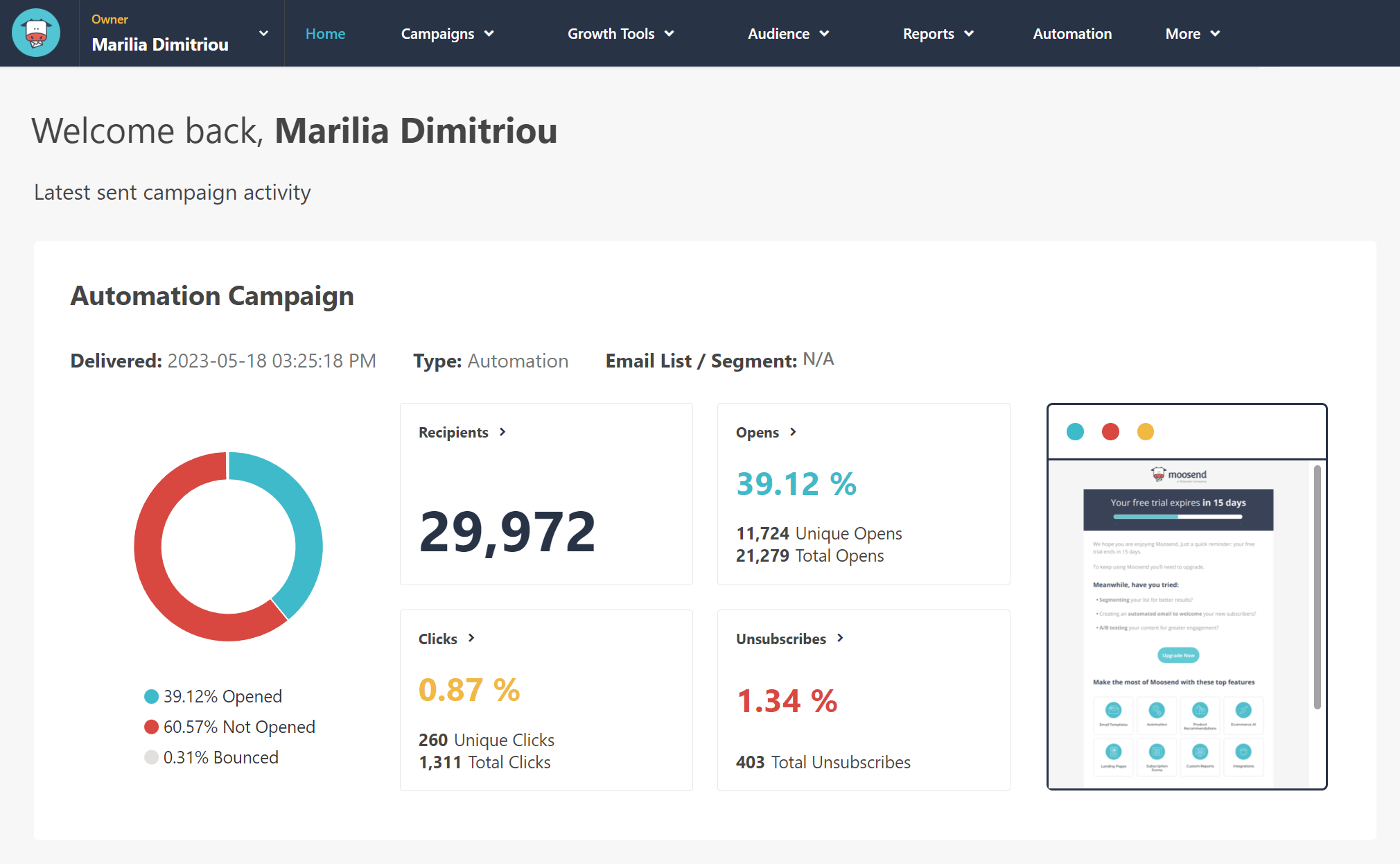
Pricing: Paid plans start at $9/month, 30-day free trial (Sign up here)
Best Feature: Advanced eCommerce automation with real-time behavior triggers
Moosend is among the best email marketing services for eCommerce businesses, offering a surprisingly robust feature set for its price point. You can use its powerful visual automation builder, advanced segmentation tools, real-time tracking, product recommendation blocks, and landing pages even on lower-tier plans. With its easy-to-use drag-and-drop editor and pre-built automation templates, you’ll quickly send abandoned cart flows, welcome sequences, and post-purchase follow-ups. And with Moosend’s built-in AI tools, you’ll be able to generate copy fast, personalize your campaigns, and build smart segments to boost your sales. At the same time, its robust API will handle all your transactional messages.
Why prefer Moosend: If you’re running an online store and need serious automation and personalization without the high price tag of Klaviyo or Mailchimp, Moosend is a smart choice that balances performance and affordability.
2. ActiveCampaign
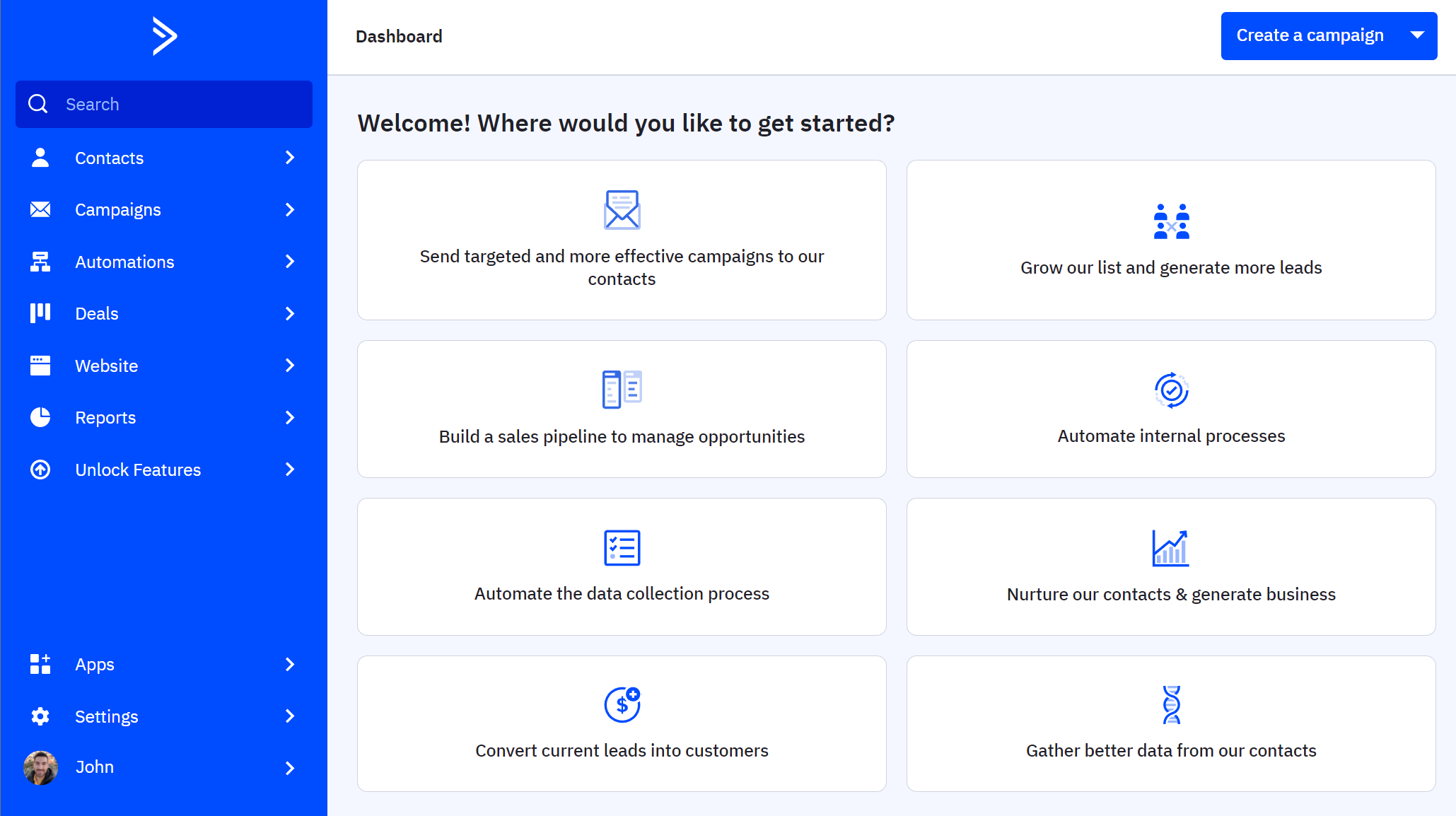
Pricing: Paid plans start at $19/month, 14-day free trial
Best Feature: Deep automation workflows with built-in CRM
ActiveCampaign combines email marketing, sales automation, and CRM features into one system. For eCommerce users, ActiveCampaign offers behavioral tracking, conditional content, dynamic email blocks, and multi-channel automation across email, SMS, and site messaging. The platform’s Automations Map gives you a full visual overview of your customer journeys, very helpful for larger teams or complex workflows. You also get a vast library of pre-made automation journeys to kickstart your email strategy. While it has a steeper learning curve than Mailchimp or Moosend, the tradeoff is great control and customization.
Why prefer ActiveCampaign: You need advanced customer journeys or want to build complex automations across multiple channels.
3. Omnisend
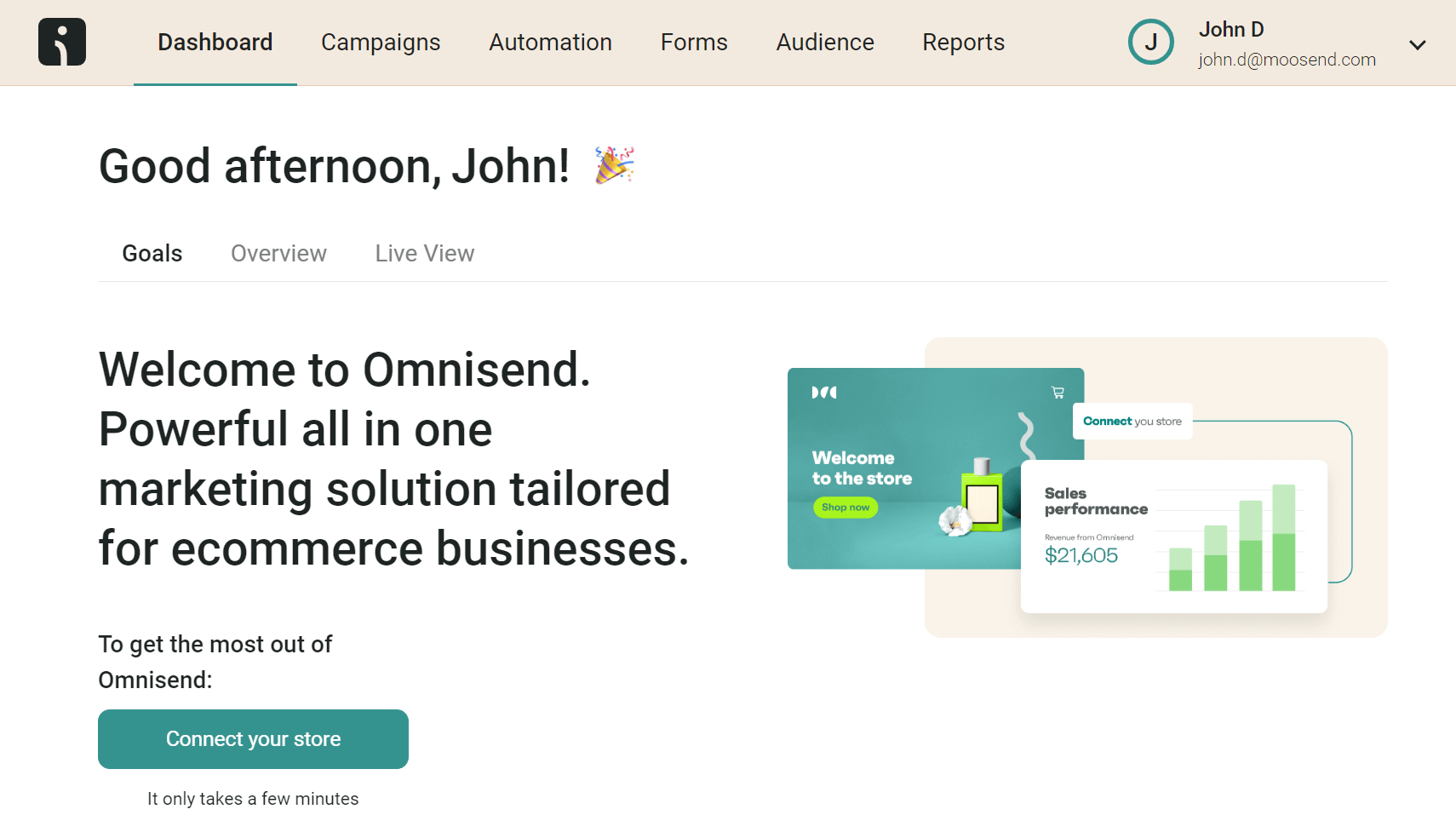
Pricing: Paid plans start at $16/month, free plan
Best Feature: Omnichannel automation with email, SMS, and push notifications
Omnisend is purpose-built for eCommerce combining email marketing, SMS, and push campaigns. Its visual automation builder is highly intuitiveand lets you design sophisticated workflows triggered by shopping behavior, cart activity, and lifecycle stages. It includes a robust selection of pre-built templates, gamified signup forms, and dynamic product recommendations. Unlike many tools, Omnisend allows users to blend multiple channels within a single automation flow, improving engagement and customer retention.
Why prefer Omnisend: You want to unify your messaging across email, SMS, and push without using multiple tools.
Additional Resources to Check
Here are a few resources to expand your reading:
Klaviyo vs Mailchimp: The Takeaway
Both Klaviyo and Mailchimp are great email marketing platforms, but they serve different needs. If your priority is fast campaign creation with flexible design tools and you’re not heavily reliant on behavioral data, Mailchimp is a better fit. But if you’re running a growing online store and want a platform that works seamlessly with your product catalog, automates based on customer behavior, and clearly ties marketing actions to revenue, Klaviyo is the stronger long-term investment.
The best way to decide is to test both platforms using their free plans and see which one aligns best with your business goals and workflow.
